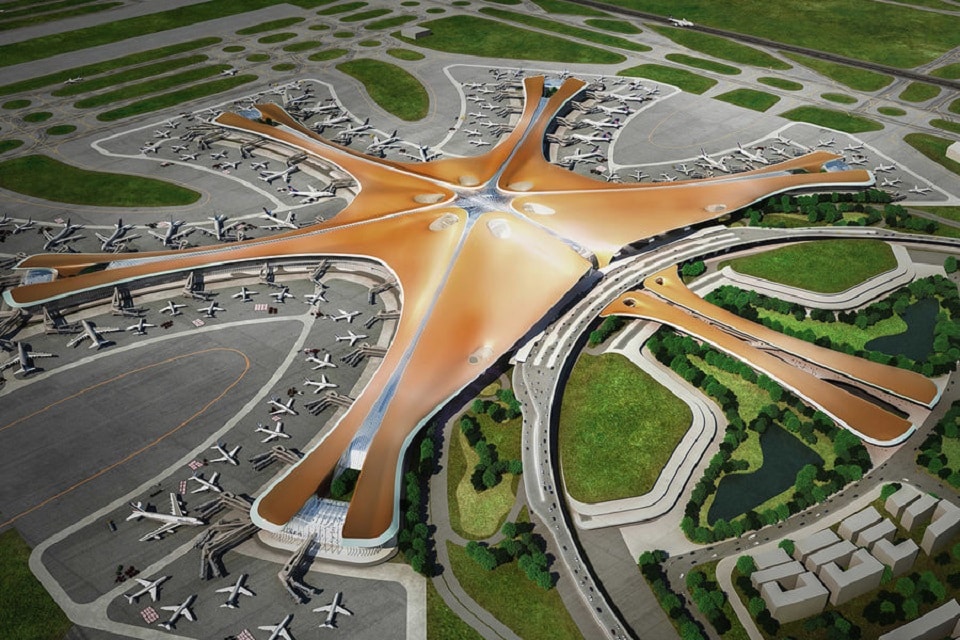Aviation
British Airways makes first flight into Beijing Daxing, the airport of the future

- British Airways has today made its first flight into Beijing Daxing International Airport
- The airline is the first international carrier to fly into the state-of-the-art airport since it was officially opened last month
Sunday October 27 – British Airways has today made its first flight into the new state-of-the-art Beijing Daxing International Airport. British Airways is the first international airline to do so since the airport – one of the most technologically advanced in the world – was officially opened last month.
The maiden flight, on a Boeing 777-300, arrived this morning at 09.15 local time. Go Pro footage from the flight shows the extraordinary view of the airport that greeted flight crew on their descent. British Airways will run a daily service between Heathrow and Beijing Daxing, with four cabins: First, Club World (business class), World Traveller Plus (premium economy) and World Traveller (economy). Fares start from £414 return and British Airways Executive Club members will gain enhanced frequent flyer benefits and Avios can be used on reward flights, upgrades, hotels, experiences and for part payment, allowing customers to cut the cost of future British Airways flights.
British Airways customers arriving in Beijing Daxing are set to experience a range of innovations as they travel through the stunning new terminal building, including facial recognition and self-service biometrics at security, self-service check-in kiosks and baggage drop machines, a paperless journey from check-in to boarding, and real-time baggage tracking.
The following Avios part payment options are available for Heathrow to Daxing, based on a fare of £414:
| £393.42 plus 2,000 Avios |
| £373.42 plus 5,500 Avios |
| £343.42 plus 11,600 Avios |
| £313.42 plus 18,400 Avios |
| £263.42 plus 30,500 Avios |
| £213.42 plus 42,500 Avios |

Airlines
Air India to Launch aircraft maintenance training institute in Bengaluru

Air India, one of India’s leading global airlines, is set to establish a Basic Maintenance Training Organization (BMTO) in Bengaluru.
This institute will offer a comprehensive Aircraft Maintenance Engineering (AME) program certified by the Directorate General of Civil Aviation (DGCA). The program will follow an integrated 2+2 year structure, combining classroom learning with practical, hands-on training.
This initiative is part of Air India’s broader goal of creating a robust aviation ecosystem in India. With plans to expand its fleet and strengthen its operations, the airline aims to build a skilled workforce of maintenance engineers, making the organization self-reliant while supporting its ambitious transformation journey.
This country tops visa rejections in the popular Schengen countries
To bring this vision to life, air india has partnered with Bengaluru Airport City Limited (BACL), a subsidiary of Bangalore International Airport Limited (BIAL). Together, they will develop a state-of-the-art facility spanning 86,000 square feet at Bengaluru Airport City.
This purpose-built campus will feature modern classrooms, well-equipped laboratories, and qualified trainers to deliver world-class education and training. The institute is expected to become operational by mid-2026.
The BMTO will be located close to Air India’s new 12-bay Maintenance, Repair, and Overhaul (MRO) facility, also set to open in Bengaluru by early 2026. The AME program will begin with two years of academic coursework, followed by two years of practical training at the MRO, ensuring students receive hands-on experience adhering to industry standards.
Sanctions & Engine Issues Ground Half of Russia’s A320neo fleet
In the meantime, Air India has introduced a Cadet AME program in collaboration with reputable institutions in Bengaluru and Hyderabad.
This ensures continuity in its commitment to developing skilled aircraft maintenance engineers while the BMTO facility is under construction. The program also allows students to pursue a bachelor’s degree through university partnerships, enhancing their career and academic opportunities.
With this initiative, air india plane aims to address the growing demand for skilled professionals in aircraft maintenance and engineering, air india new planes contributing to the development of India’s aviation sector and creating specialized career paths for aspiring engineers.
-

 Aviation2 months ago
Aviation2 months agoMicrosoft Flight Simulator Raises $3 Million to Bring Back the An-225 Mriya
-

 Airlines2 months ago
Airlines2 months agoQatar Citizens Can Travel to the United States Without a Visa
-

 Aviation2 months ago
Aviation2 months agoQatar Airways bans these new Electronic Devices on plane
-

 Airlines2 months ago
Airlines2 months agoJapan Airlines Rolls Out Free Domestic Flights to International Passengers
-

 Defence2 months ago
Defence2 months agoWhich Country Has the Largest Fleet of Fighter Aircraft?
-

 Airport2 months ago
Airport2 months agoWestern Sydney Airport Welcomes Its First Plane After 6 Years of construction
-

 Travel2 months ago
Travel2 months agoQatar Airways Launches Four Additional Flights from Amsterdam
-

 Aviation2 months ago
Aviation2 months agoDid you know ? Once Boeing 747 carried 1088 passenger in 1991








